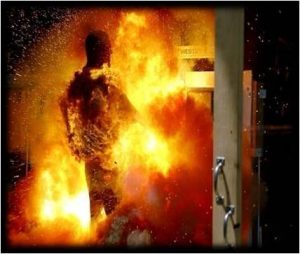
In this series of short articles, four aspects of arc-suppression blankets will be covered: (1) heat (2) blast and pressure wave (3) burning and (4) installation suggestions.
The major reason for arc-suppression blankets is protection from the intense heat.  Although testing has indicated source temperatures of over 30,000 degrees F, it is extremely rare that a person has contact with surfaces that hot. Almost all contact is with the plasma, air heated to temperatures of 5,000 to 10,000 degrees F. Exposure to the plasma, although very brief, has catastrophic consequences on an unprotected person. Arc-suppression blankets are designed to re-direct or absorb the plasma heat energy. They accomplish re-directing by channeling the energy to a safer place such as out a manhole. Absorption takes place by a process called ablation. In this process, layers of material are burned away one at a time allowing the remaining layers to continue to protect. Since blankets are rated for a certain energy level, the certification verified a blankets ability to withstand the plasma heat. As an example, a 40 KA (thousand amp) blanket must not burn through within 10 cycles from a directed arc source.
Although testing has indicated source temperatures of over 30,000 degrees F, it is extremely rare that a person has contact with surfaces that hot. Almost all contact is with the plasma, air heated to temperatures of 5,000 to 10,000 degrees F. Exposure to the plasma, although very brief, has catastrophic consequences on an unprotected person. Arc-suppression blankets are designed to re-direct or absorb the plasma heat energy. They accomplish re-directing by channeling the energy to a safer place such as out a manhole. Absorption takes place by a process called ablation. In this process, layers of material are burned away one at a time allowing the remaining layers to continue to protect. Since blankets are rated for a certain energy level, the certification verified a blankets ability to withstand the plasma heat. As an example, a 40 KA (thousand amp) blanket must not burn through within 10 cycles from a directed arc source.
Heat energy dissipates as the square of the distance from the source. This fact is used in determining worker protection. If the caloric energy is 16 calories per square cm at one foot, at two feet, it is (1/2) squared or 4 calories. This energy reduction emphasizes the importance of making the heat energy travel as far as possible before it reaches a worker. Using the largest appropriately rated blanket for the environment forces the energy to go from the source to the edges of the blanket and then possibly to the worker.
Therm-Equip™ has six certifications for arc-suppression blankets. Three of these are for 25 KA and three for 40 KA rated units. Since the original 25 KA and 40 KA blankets received certifications, material and construction advances over the past eight years prompted new testing and certification to confirm these advances.
For more information or to discuss possible applications for your needs, contact Therm-Equip, Inc.
Look for the 2nd article in the series about blast and pressure waves coming in August!
